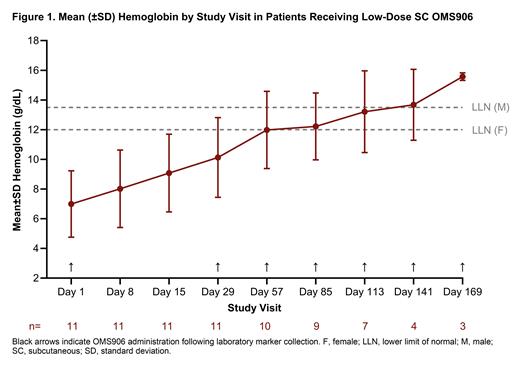Background: Paroxysmal nocturnal hemoglobinuria (PNH) is a life-threatening disorder characterized by hemolytic anemia in combination with various degrees of marrow failure. PNH is driven by dysregulation of the complement system where the absence of CD55 and CD59 cell surface proteins leads to red blood cell (RBC) lysis. Untreated PNH can lead to debilitating anemia, thrombosis, fatigue, and increased mortality. Terminal complement inhibition attenuates intravascular hemolysis (IVH) but inevitably leads to extravascular hemolysis (EVH). Proximal and alternative pathway (AP) inhibition block both IVH and EVH, as demonstrated with C3, Factor B, and Factor D inhibitors. Mannan-binding lectin-associated serine protease-3 (MASP-3) activates pro-Factor D, thus activating the AP upstream of Factor D. OMS906 is a highly selective humanized mAb that binds to and inhibits MASP-3. In a Phase 1 study in healthy subjects, OMS906 was well tolerated and provided substantial MASP-3 inhibition. In the present study, safety and efficacy of OMS906 were evaluated in complement-inhibitor treatment-naïve patients with PNH.
Methods: This is an ongoing, single-arm, open-label, Phase 1b proof-of-concept clinical trial (NCT05889299; EudraCT 2022-002450-22) evaluating safety, pharmacokinetics, pharmacodynamics, and preliminary efficacy of OMS906 in adults with PNH. Eligibility criteria include: confirmed PNH diagnosis by flow cytometry (RBC clone size >10%); complement-inhibitor treatment-naïve or inadequate response to C5 inhibitors; and baseline hemoglobin (Hgb) <10.5 g/dL. Patients received 5 mg/kg subcutaneous (SC) OMS906 every 4 weeks, the lowest exposure cohort in this study. Primary endpoints are safety and tolerability. Secondary endpoints include changes from baseline in Hgb and lactate dehydrogenase (LDH) levels, RBC clone size, and absolute reticulocyte count; achievement of Hgb ≥12 g/dL or an increase of ≥2 g/dL; and transfusion independence. Planned enrollment was approximately 10 patients.
Results: This pre-specified interim analysis included data available as of July 20, 2023. All patients (N=11) included in this analysis were complement-inhibitor treatment-naïve (55% female; mean age 41 years [range 27-72]). The majority of patients (64%) received RBC transfusions in the 12 months prior to OMS906 treatment. Co-existing conditions included iron deficiency (n=6), chronic renal failure (n=3), aplastic anemia (n=2), and myelodysplastic syndrome (MDS; n=2). At baseline (N=11), mean Hgb was 7.0 g/dL (median 6.4 g/dL, range 3.9-10.4 g/dL) and LDH was 1835 U/L (median 1831 U/L, range 905-3480). To date, all patients have received ≥2 doses of OMS906 with 4 patients having received ≥6 doses. OMS906 was well tolerated. The most common adverse events (AEs) in ≥20% of patients were increased thrombocytopenia (36%), neutropenia (27%), and itching (27%). No patients experienced clinical breakthrough hemolysis. There were no major adverse vascular events, treatment-related serious AEs, discontinuations, or deaths. Following initiation of OMS906, mean Hgb increased from baseline by 3.1 g/dL ( P<0.001) at 4 weeks (N=11), and by 9.5 g/dL ( P=0.016) at the latest timepoint of 24 weeks (n=3) [Figure 1]. Among patients receiving ≥2 doses, all but 3 experienced gender-specific normalization of Hgb levels. The remaining patients had MDS (n=2) or marrow failure (n=1). No patients required transfusions following OMS906 treatment. Mean LDH levels decreased from baseline by 1483 U/L (>80%; P<0.001) at 4 weeks (N=11) and by 1939 U/L ( P=0.004) at 24 weeks (n=3). Three patients had increases in LDH, suggesting initiation of hemolysis at the end of a dosing period. Mean absolute reticulocyte counts decreased from baseline by 87,000-122,000 ×10 9/L at all timepoints. Mean PNH RBC clone size increased by up to 38.6% (n=6; P=0.016) versus baseline.
Conclusion: In this interim analysis, MASP-3 inhibitor OMS906 was well tolerated with no safety signals of concern. Once-monthly SC OMS906 resulted in clinically meaningful, beneficial effects on Hgb, LDH, and RBC clone size in treatment-naïve PNH patients. OMS906 dose escalation guided by occurrence of subclinical hemolysis is being evaluated with the goal of achieving quarterly dosing.
Disclosures
Nangia:Omeros Corporation: Current Employment. Osborne:Omeros Corporation: Current Employment, Current equity holder in publicly-traded company. Whitaker:Omeros Corporation: Current Employment, Current equity holder in publicly-traded company. Gavriilaki:Pfizer and Jazz Pharmaceuticals: Research Funding; Alexion, AstraZeneca, Omeros, Sanofi, Sobi: Honoraria. Panse:F. Hoffmann-La Roche Ltd,: Membership on an entity's Board of Directors or advisory committees, Other: Third party writing assistance by Akshaya Srinivasan, PhD, of MediTech Media Ltd and funded by F. Hoffmann-La Roche Ltd, , Speakers Bureau; Alexion, AstraZeneca Rare Disease: Membership on an entity's Board of Directors or advisory committees, Speakers Bureau; Apellis Pharmaceuticals, Inc.: Consultancy; Amgen: Consultancy; Boehringer Ingelheim: Membership on an entity's Board of Directors or advisory committees, Speakers Bureau; BMS: Consultancy; SOBI: Membership on an entity's Board of Directors or advisory committees, Speakers Bureau; Novartis: Membership on an entity's Board of Directors or advisory committees, Speakers Bureau; Pfizer: Membership on an entity's Board of Directors or advisory committees, Speakers Bureau; Samsung Bioepis: Membership on an entity's Board of Directors or advisory committees, Speakers Bureau; Blueprint Medicines: Membership on an entity's Board of Directors or advisory committees, Speakers Bureau; MSD: Consultancy; Sanofi Ltd: Consultancy.


